belt NISSAN ALTIMA 2020 Owner´s Manual
[x] Cancel search | Manufacturer: NISSAN, Model Year: 2020, Model line: ALTIMA, Model: NISSAN ALTIMA 2020Pages: 559, PDF Size: 6.3 MB
Page 6 of 559
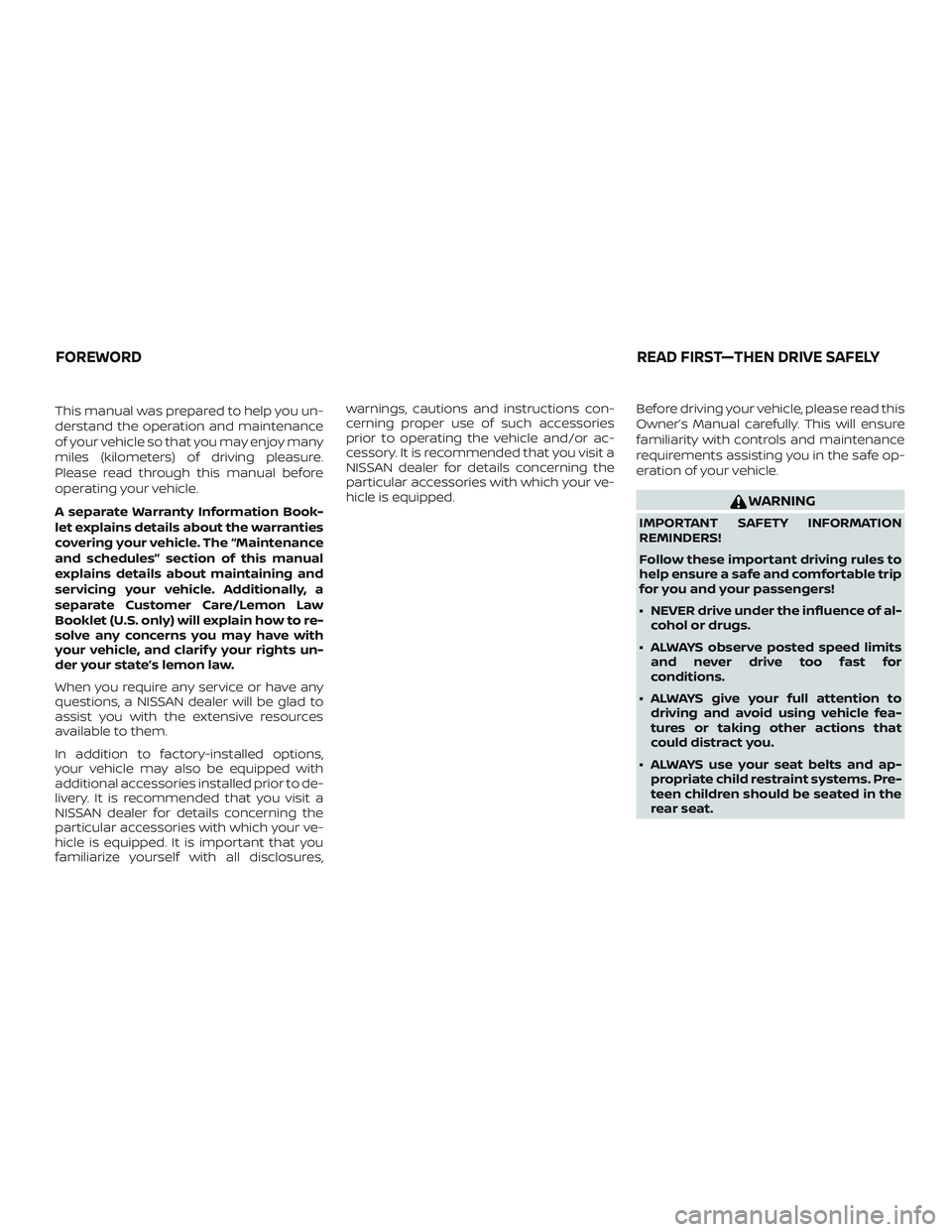
This manual was prepared to help you un-
derstand the operation and maintenance
of your vehicle so that you may enjoy many
miles (kilometers) of driving pleasure.
Please read through this manual before
operating your vehicle.
A separate Warranty Information Book-
let explains details about the warranties
covering your vehicle. The “Maintenance
and schedules” section of this manual
explains details about maintaining and
servicing your vehicle. Additionally, a
separate Customer Care/Lemon Law
Booklet (U.S. only) will explain how to re-
solve any concerns you may have with
your vehicle, and clarif y your rights un-
der your state’s lemon law.
When you require any service or have any
questions, a NISSAN dealer will be glad to
assist you with the extensive resources
available to them.
In addition to factory-installed options,
your vehicle may also be equipped with
additional accessories installed prior to de-
livery. It is recommended that you visit a
NISSAN dealer for details concerning the
particular accessories with which your ve-
hicle is equipped. It is important that you
familiarize yourself with all disclosures,warnings, cautions and instructions con-
cerning proper use of such accessories
prior to operating the vehicle and/or ac-
cessory. It is recommended that you visit a
NISSAN dealer for details concerning the
particular accessories with which your ve-
hicle is equipped.
Before driving your vehicle, please read this
Owner’s Manual carefully. This will ensure
familiarity with controls and maintenance
requirements assisting you in the safe op-
eration of your vehicle.
WARNING
IMPORTANT SAFETY INFORMATION
REMINDERS!
Follow these important driving rules to
help ensure a safe and comfortable trip
for you and your passengers!
∙ NEVER drive under the influence of al-
cohol or drugs.
∙ ALWAYS observe posted speed limits and never drive too fast for
conditions.
∙ ALWAYS give your full attention to driving and avoid using vehicle fea-
tures or taking other actions that
could distract you.
∙ ALWAYS use your seat belts and ap- propriate child restraint systems. Pre-
teen children should be seated in the
rear seat.
FOREWORD READ FIRST—THEN DRIVE SAFELY
Page 12 of 559

Table of
ContentsIllustrated table of contents
Safety—Seats, seat belts and supplemental restraint system
Instruments and controls
Pre-driving checks and adjustments
Monitor, climate, audio, phone and voice recognition systems
Starting and driving
In case of emergency
Appearance and care
Do-it-yourself
Maintenance and schedules
Technical and consumer information
Index
0
1
2
3
4
5
6
7
8
9
10
11
Page 14 of 559
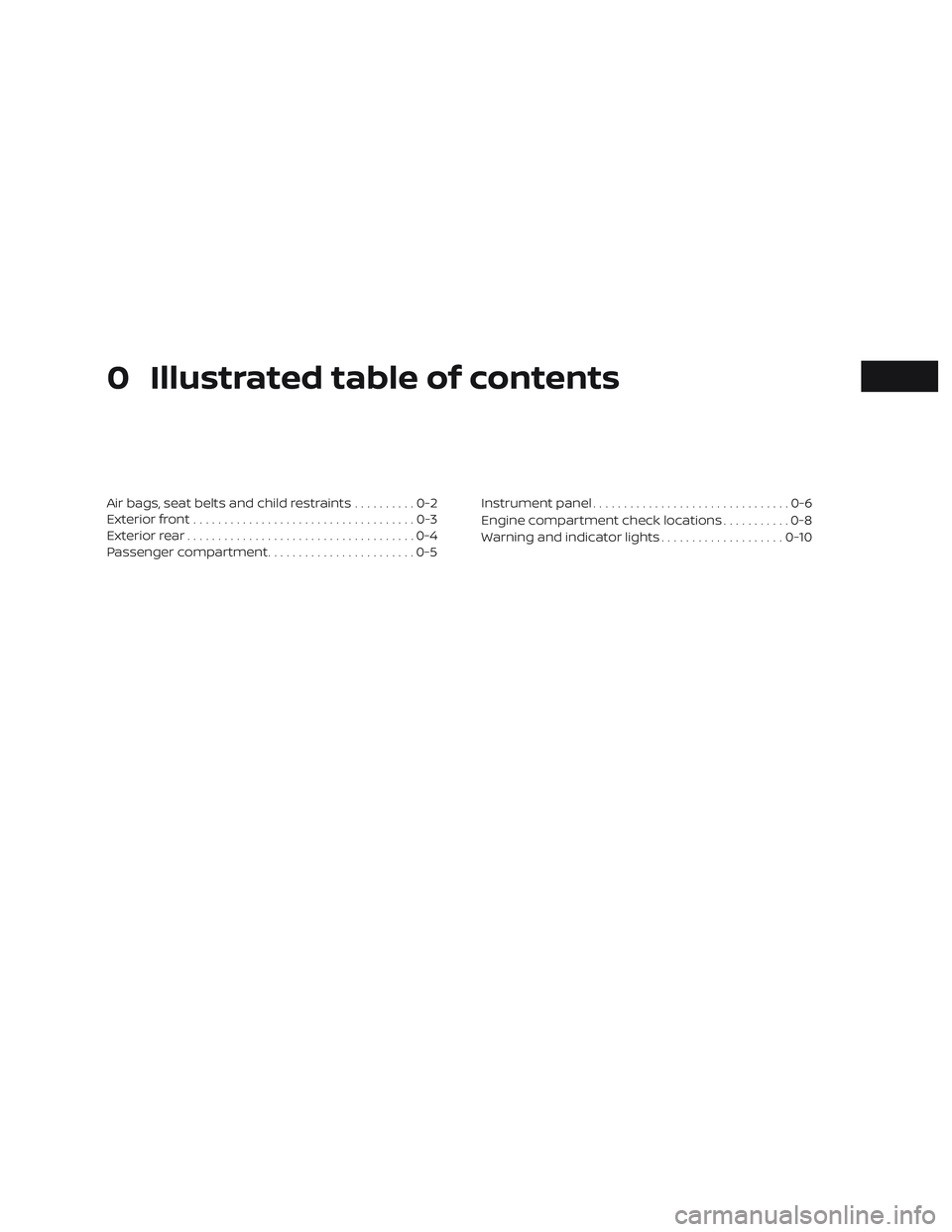
0 Illustrated table of contents
Air bags, seat belts and child restraints..........0-2
Exterior front ....................................0-3
Exterior rear .....................................0-4
Passenger compartment ........................0-5 Instrument panel
................................0-6
Engine compartment check locations ...........0-8
Warning and indicator lights ....................0-10
Page 15 of 559
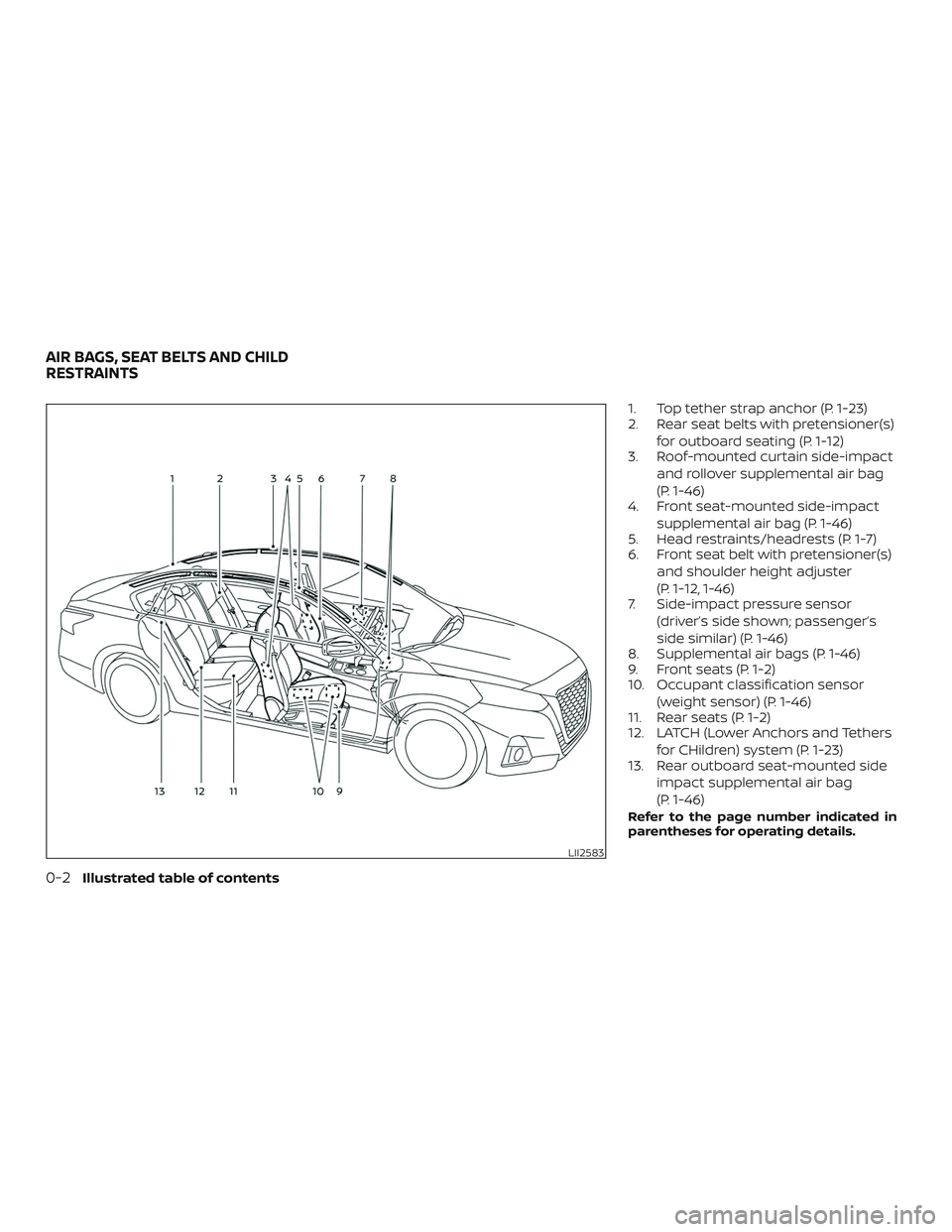
1. Top tether strap anchor (P. 1-23)
2. Rear seat belts with pretensioner(s)for outboard seating (P. 1-12)
3. Roof-mounted curtain side-impact
and rollover supplemental air bag
(P. 1-46)
4. Front seat-mounted side-impact
supplemental air bag (P. 1-46)
5. Head restraints/headrests (P. 1-7)
6. Front seat belt with pretensioner(s)
and shoulder height adjuster
(P. 1-12, 1-46)
7. Side-impact pressure sensor
(driver’s side shown; passenger’s
side similar) (P. 1-46)
8. Supplemental air bags (P. 1-46)
9. Front seats (P. 1-2)
10. Occupant classification sensor
(weight sensor) (P. 1-46)
11. Rear seats (P. 1-2)
12. LATCH (Lower Anchors and Tethers
for CHildren) system (P. 1-23)
13. Rear outboard seat-mounted side
impact supplemental air bag
(P. 1-46)
Refer to the page number indicated in
parentheses for operating details.
LII2583
AIR BAGS, SEAT BELTS AND CHILD
RESTRAINTS
0-2Illustrated table of contents
Page 21 of 559
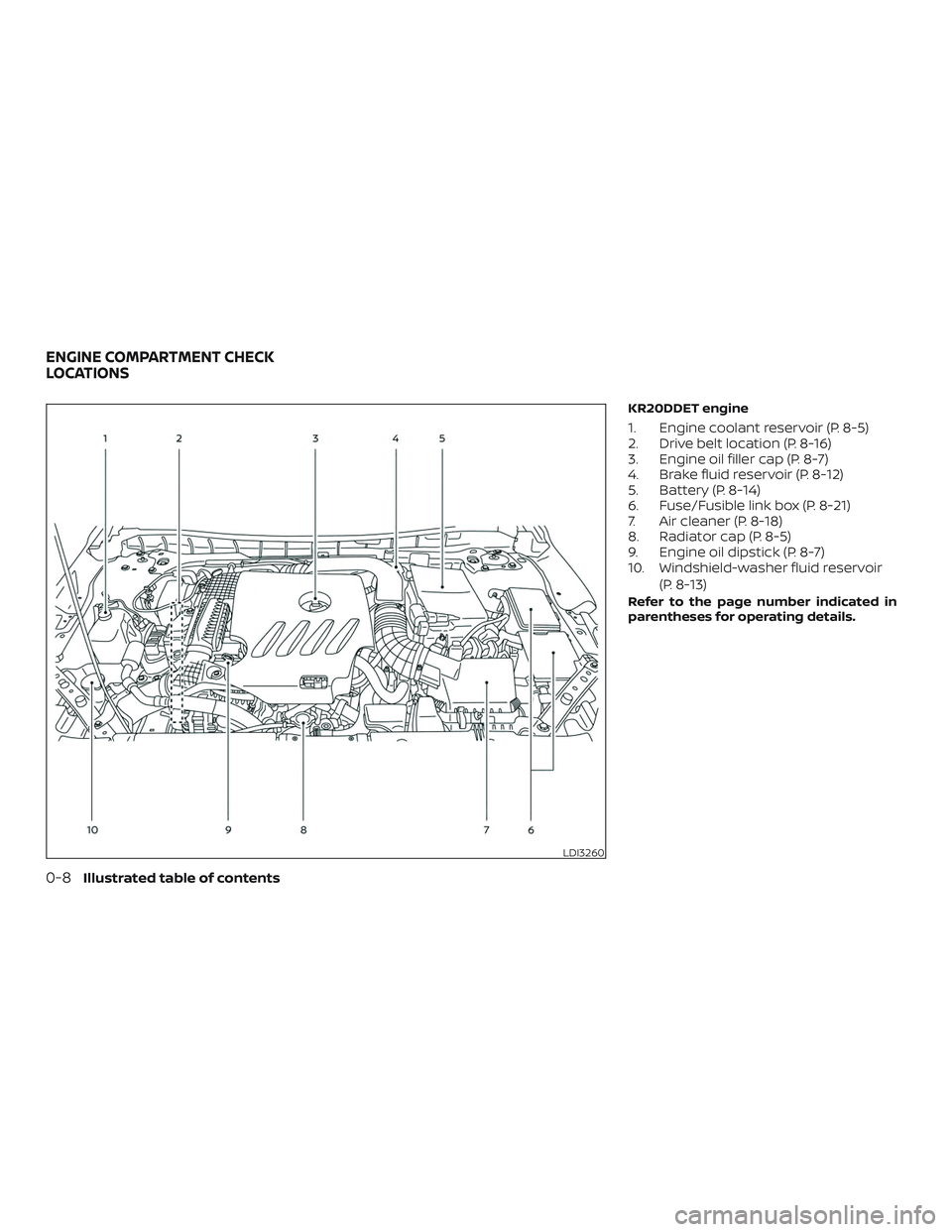
KR20DDET engine
1. Engine coolant reservoir (P. 8-5)
2. Drive belt location (P. 8-16)
3. Engine oil filler cap (P. 8-7)
4. Brake fluid reservoir (P. 8-12)
5. Battery (P. 8-14)
6. Fuse/Fusible link box (P. 8-21)
7. Air cleaner (P. 8-18)
8. Radiator cap (P. 8-5)
9. Engine oil dipstick (P. 8-7)
10. Windshield-washer fluid reservoir(P. 8-13)
Refer to the page number indicated in
parentheses for operating details.
LDI3260
ENGINE COMPARTMENT CHECK
LOCATIONS
0-8Illustrated table of contents
Page 22 of 559
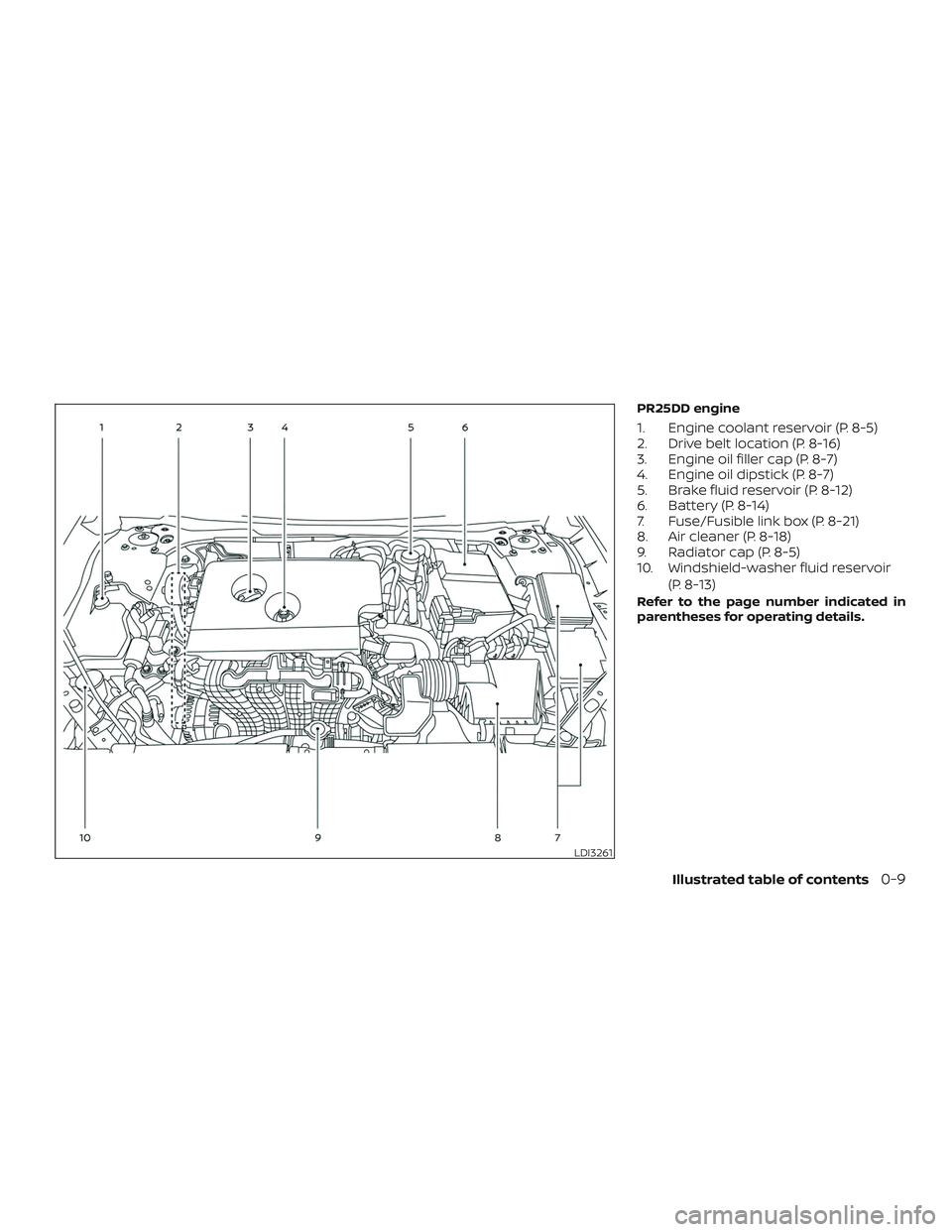
PR25DD engine
1. Engine coolant reservoir (P. 8-5)
2. Drive belt location (P. 8-16)
3. Engine oil filler cap (P. 8-7)
4. Engine oil dipstick (P. 8-7)
5. Brake fluid reservoir (P. 8-12)
6. Battery (P. 8-14)
7. Fuse/Fusible link box (P. 8-21)
8. Air cleaner (P. 8-18)
9. Radiator cap (P. 8-5)
10. Windshield-washer fluid reservoir(P. 8-13)
Refer to the page number indicated in
parentheses for operating details.
LDI3261
Illustrated table of contents0-9
Page 23 of 559
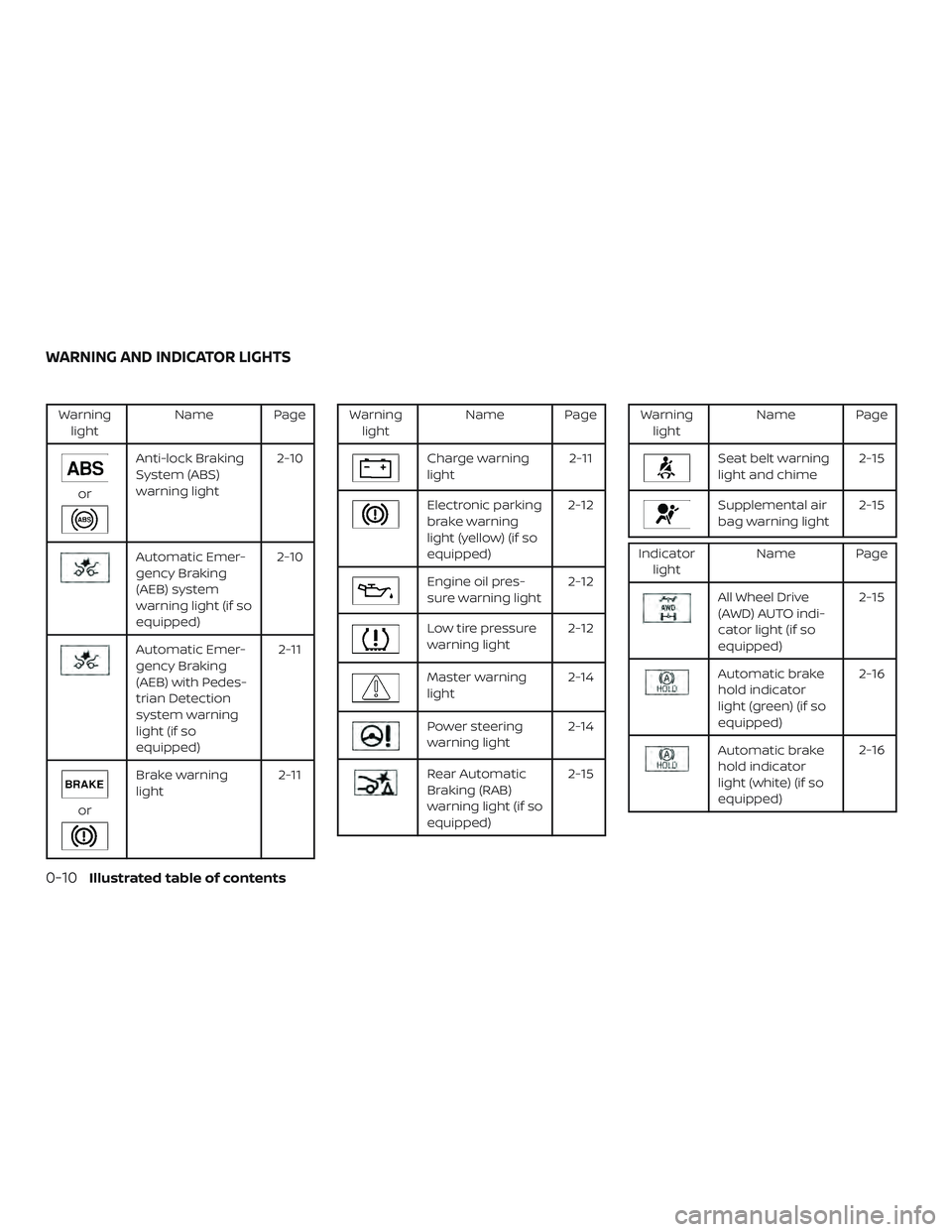
Warninglight Name Page
or
Anti-lock Braking
System (ABS)
warning light 2-10
Automatic Emer-
gency Braking
(AEB) system
warning light (if so
equipped)2-10
Automatic Emer-
gency Braking
(AEB) with Pedes-
trian Detection
system warning
light (if so
equipped) 2-11
or
Brake warning
light
2-11
Warning
light Name Page
Charge warning
light 2-11
Electronic parking
brake warning
light (yellow) (if so
equipped)2-12
Engine oil pres-
sure warning light
2-12
Low tire pressure
warning light2-12
Master warning
light2-14
Power steering
warning light2-14
Rear Automatic
Braking (RAB)
warning light (if so
equipped) 2-15
Warning
light Name Page
Seat belt warning
light and chime 2-15
Supplemental air
bag warning light2-15
Indicator
light Name Page
All Wheel Drive
(AWD) AUTO indi-
cator light (if so
equipped) 2-15
Automatic brake
hold indicator
light (green) (if so
equipped)2-16
Automatic brake
hold indicator
light (white) (if so
equipped)2-16
WARNING AND INDICATOR LIGHTS
0-10Illustrated table of contents
Page 26 of 559

1 Safety—Seats, seat belts and
supplemental restraint system
Seats............................................ 1-2Front manual seat adjustment
(if so equipped for passenger’s seat) ...........1-3
Front power seat adjustment
(for driver’s seat and if so equipped for
passenger’s seat) ............................. 1-4
Folding rear seat ............................. 1-5
Center armrest ................................1-7
Head restraints/headrests .......................1-7
Adjustable head restraint/headrest
components ................................. 1-8
Non-adjustable head restraint/
headrest components ........................ 1-9
Remove...................................... 1-9
Install ......................................... 1-10
Adjust ........................................ 1-10
Seatbelts ....................................... 1-12
Precautions on seat belt usage ...............1-12
Seat belt warning light and chime ............1-14
Pregnant women ............................. 1-15
Injured persons ............................... 1-15
Three-point type seat belt with
retractor ..................................... 1-15Seat belt extenders
.......................... 1-20
Seat belt maintenance ......................1-20
Child safety ...................................... 1-21
Infants ...................................... 1-22
Small children ............................... 1-22
Larger children .............................. 1-22
Child restraints ................................. 1-23
Precautions on child restraints ..............1-23
LATCH (Lower Anchors and Tethers for
CHildren) system ............................ 1-26
Rear-facing child restraint installation
using LATCH ................................. 1-28
Rear-facing child restraint installation
using the seat belts .......................... 1-31
Forward-facing child restraint
installation using LATCH .....................1-34
Forward-facing child restraint
installation using the seat belts ..............1-38
Booster seats ............................... 1-42
Supplemental Restraint System (SRS) ...........1-46
Precautions on SRS .......................... 1-46
Supplemental air bag warning labels ........1-67
Supplemental air bag warning light ..........1-67
Page 27 of 559
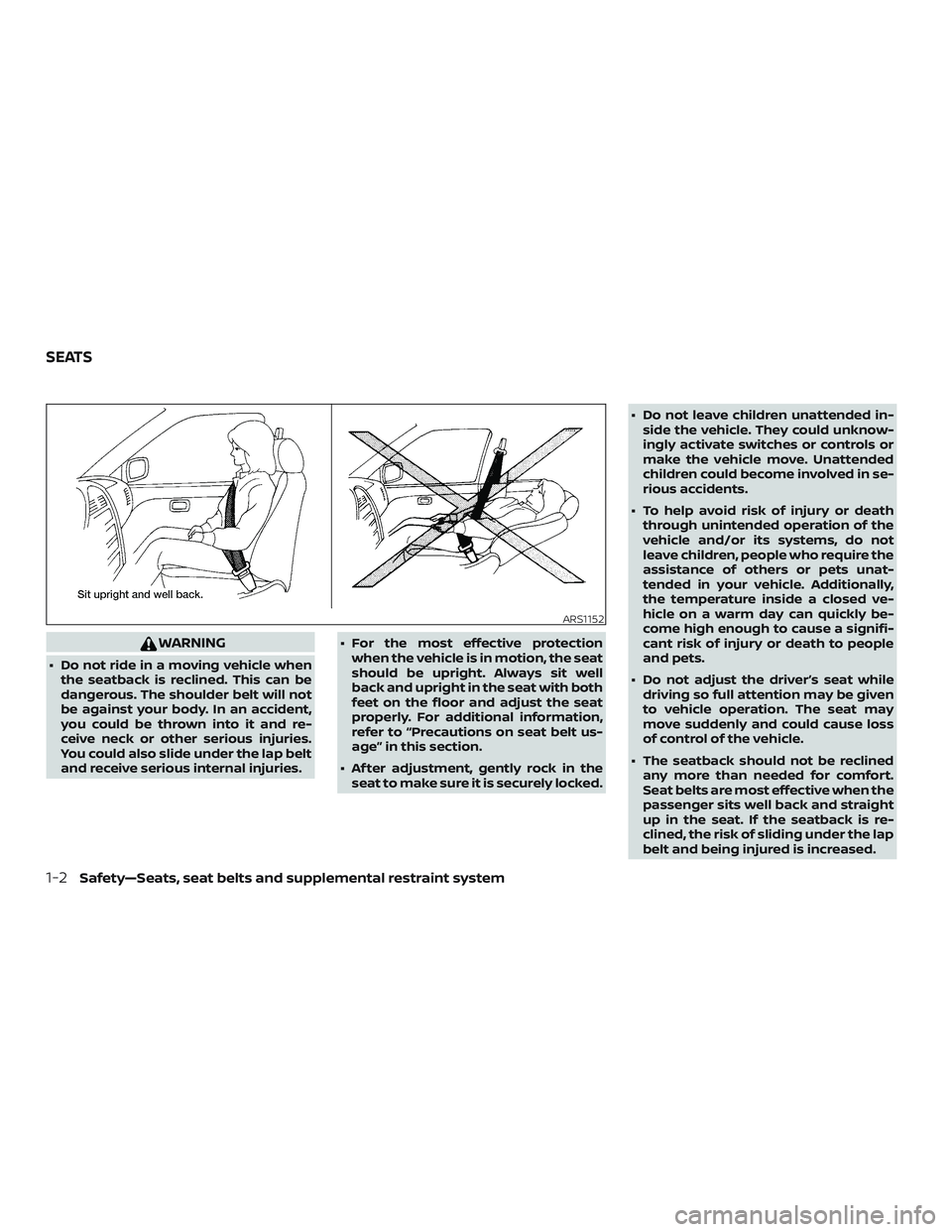
WARNING
∙ Do not ride in a moving vehicle whenthe seatback is reclined. This can be
dangerous. The shoulder belt will not
be against your body. In an accident,
you could be thrown into it and re-
ceive neck or other serious injuries.
You could also slide under the lap belt
and receive serious internal injuries. ∙ For the most effective protection
when the vehicle is in motion, the seat
should be upright. Always sit well
back and upright in the seat with both
feet on the floor and adjust the seat
properly. For additional information,
refer to “Precautions on seat belt us-
age” in this section.
∙ Af ter adjustment, gently rock in the seat to make sure it is securely locked. ∙ Do not leave children unattended in-
side the vehicle. They could unknow-
ingly activate switches or controls or
make the vehicle move. Unattended
children could become involved in se-
rious accidents.
∙ To help avoid risk of injury or death through unintended operation of the
vehicle and/or its systems, do not
leave children, people who require the
assistance of others or pets unat-
tended in your vehicle. Additionally,
the temperature inside a closed ve-
hicle on a warm day can quickly be-
come high enough to cause a signifi-
cant risk of injury or death to people
and pets.
∙ Do not adjust the driver’s seat while driving so full attention may be given
to vehicle operation. The seat may
move suddenly and could cause loss
of control of the vehicle.
∙ The seatback should not be reclined any more than needed for comfort.
Seat belts are most effective when the
passenger sits well back and straight
up in the seat. If the seatback is re-
clined, the risk of sliding under the lap
belt and being injured is increased.
ARS1152
SEATS
1-2Safety—Seats, seat belts and supplemental restraint system
Page 28 of 559

CAUTION
When adjusting the seat positions, be
sure not to contact any moving parts to
avoid possible injuries and/or damage.
FRONT MANUAL SEAT
ADJUSTMENT (if so equipped for
passenger’s seat)
Your vehicle seats can be adjusted manu-
ally. For additional information about ad-
justing the seats, refer to the steps outlined
in this section.
Forward and backward
Pull the center of the bar up and hold it
while you slide the seat forward or back-
ward to the desired position. Release the
bar to lock the seat in position.
Reclining
To recline the seatback, pull the lever up
and lean back. To bring the seatback for-
ward, pull the lever up and lean your body
forward. Release the lever to lock the seat-
back in position.
The reclining feature allows adjustment of
the seatback for occupants of different
sizes for added comfort and to help obtain
proper seat belt fit. For additional informa-
tion, refer to “Precautions on seat belt us-
age” in this section. Also, the seatback can
be reclined to allow occupants to rest
when the vehicle is stopped and the shif t
lever is in the P (Park) position.
LRS3029LRS3030
Safety—Seats, seat belts and supplemental restraint system1-3